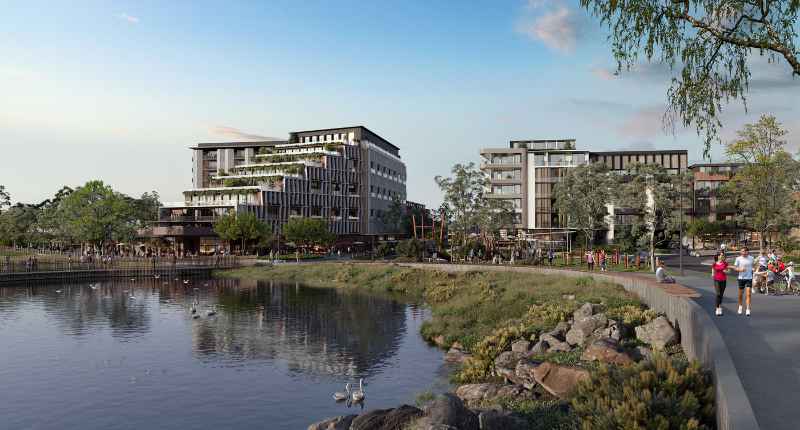- Low prices, amenities, and infrastructure development attracting businesses.
- Developers in Cheltenham and Mulgrave are refashioning old warehouses into new, modern, and architecturally designed workplaces.
- Hotspots include Epping, Williams Landing, Cheltenham, and Mulgrave.
Melbourne’s outer ring is in hot demand, with residents and businesses flocking to these urban epicentres, attracted by affordability, space, amenities, and infrastructure.
Indeed, these areas are seeing intensified investment in their development as corporations seek to pull more talent and expand their operations beyond the Central Business District (CBD).
Ray White Glen Waverley’s managing director, Ryan Trickey, told The Property Tribune that the unprecedented COVID-19 pandemic started this shift away from the CBD, where Australians began to rethink the workplace and work-balance priorities.
“People who own real estate residentially in the surrounding suburbs would prefer to drive five minutes to their factory or five minutes to their office. They don’t have to go to the city anymore,” Trickey says.
“They don’t need to be on the biggest most expensive street in town. They can do the same thing remotely or from a different location that suits them.”
Here are Melbourne’s most promising satellite cities and the landmark projects morphing them into self-subsistent urban work and lifestyle hubs.
Epping
This bustling suburb is about 20 kilometres (km) north of Melbourne, close to Hume Freeway and major roads and transport links. The City of Whittlesea’s population presently stands at 220,000 and is expected to double over the coming 20 years.
Substantial amounts of investment have been made into the area’s education, construction, and health sectors, turning Epping into a self-reliant community.
One of the more exciting developments in the area is New Epping, a $2 billion mixed-use project, developed by Riverlee, that will turn a disused landfill and quarry site into a vibrant city.

Spanning 51 hectares, New Epping will boast six unique precincts with living, commercial, hospitality, retail, and health uses. Touted to deliver some $3.4 billion for the state economy, New Epping will have 110,000 square metres (sqm) of commercial space and an A-grade commercial tower in the works.
The mixed-use development is expected to support a working community of 7,209 by bringing in more workplace infrastructure to the burgeoning northern corridor.
Williams Landing
Sitting just 20km southwest of the CBD, Williams Landing is in the fastest-growing municipality in Melbourne, the City of Wyndham — business registrations have quadrupled from 2017 to 2022 in the local government area, and its population is projected to increase by 56% over the coming 18 years.
Residential developer Cedar Woods aims to harness the potential of this area by investing considerably into a 225-hectare master-planned community, office hub, and shopping mall.
Hudson Hub commercial tower’s launch was accelerated not long ago after the overwhelming success of Boston Commons, Cedar Wood’s fifth office building in the suburb. In total, the commercial space available in William Landing’s freestanding office buildings is 57,600 sqm.
Cheltenham
In close proximity to residential areas, this suburb has gained the attention of businesses looking to service the needs of the growing local population. Nestled within the City of Bayside and Kingston, it hosts a combined population of around 350,000. Retail precincts and shopping centres like Westfield Southland persistently push high foot traffic and business activity in the suburb.
The variety and availability of the suburb’s commercial and industrial zones is a compelling proposition for businesses looking to grow their operations. Particularly, developers have been focusing on the urban renewal of former warehouses to reinvigorate the commercial district sustainably and fashionably.
“We’ve seen a move away from larger format industrial in these precincts and they’ve moved to more service-based industrial,” says Trickey.
“You’ve got a 5,000 sqm warehouse with an asbestos roof that guys sucked down and they go and build 20 smaller warehouses that are new shiny and suitable for import export, suitable for manufacturing and some of them suitable for hospitality food preparation.
“They have microbreweries, and take on space in areas you would normally have to be on the main road or a high street in retail shopping and pay three times the amount of rent.
“It has allowed a lot of these businesses to get up and get started.”
One example of urban renewal is Belrose by Riverlee. The adaptive reuse project offers modern, architecturally designed workplaces.
Mulgrave
In Melbourne’s southeastern suburbs, within the City of Monash, Mulgrave is increasingly popular for businesses searching for affordable office spaces outside the CBD. It is highly accessible, near Monash Freeway, Eastlink, and other major arterial roads, and it possesses excellent leisure and retail amenities, and educational institutions.
The commercial hub has experienced a 10% spike in registered businesses since 2022, with many large national and multinational corporations setting up offices and headquarters in the suburb, including Adidas, Tesla, and Nissan.
Like in Cheltenham, these developers have been snapping up older industrial spaces and carving them into smaller and newer ones. Trickey comments that Mulgrave has a booming car dealership precinct, with Volvo, Nissan, Volkswagen, Mercedes Benz, BMW, Audi, Toyota, and Tesla capitalising on these newly available spaces.
“They’re taking advantage of some of these older, larger retail spaces and opening up. So we’ve got 1 km of nearly brand-new car dealerships and showrooms, which is probably the highest concentration of well-known car brands in Melbourne East,” says Trickey.
Additionally, Mulgrave houses a number of prominent business parks and precincts, including the Nexus Business Park and Mulgrave Innovation Precinct, providing contemporary office spaces, research facilities, and amenities that draw in an assortment of businesses in the research, technology, and innovation sectors.












